#82 The Tritium Fusion Fuel Discrepancy: The Misleading Claims
Return to the Fusion Fuel Main Page
By Steven B. Krivit
Oct. 10, 2021
The Second of a Three-Part New Energy Times Investigative Science Report
Part 1: The Tritium Fusion Fuel Discrepancy: The Scientific Facts
Part 3: Serious Discrepancies with ITER and Nuclear Fusion
ABSTRACT
Significant discrepancies exist about the forthcoming ITER fusion reactor. These discrepancies could spell disaster for the ITER project as well as for future fusion reactors. Fusion promoters sold the idea of ITER to the public, news media, and elected officials primarily based on these two false claims:
FUEL SOURCE: They said the fuel for fusion was abundant, inexpensive, and universally available. Actually, one of the two required fuel components is. The other does not exist as a natural resource on Earth.
POWER GAIN: They said the ITER reactor (not just the physics reaction) was designed to produce 10 times the power it would consume. They said ITER would be the first fusion reactor (not just the physics reaction) to demonstrate net power production. Actually, if ITER works correctly, there will be no reactor power gain. The reactor will lose power.
FUSION INVESTIGATION
New Energy Times uncovered the input power requirement for the JET reactor, and thus the discrepancies with the JET and ITER reactors, on Dec. 1, 2014. We began reporting on the ITER power discrepancy on Dec. 14, 2016. We uncovered and published the input power value for ITER on Oct. 6, 2017. We began reporting on the fuel discrepancy on July 1, 2017, and published extensive reporting on the fuel discrepancy on Oct. 10, 2021.
In Part 1 of this series, we learned that any commercial fusion reactor, if one is ever built, will need a 50/50 mixture of two isotopes of hydrogen: deuterium and tritium. We learned that deuterium, as claimed, is indeed abundant, inexpensive, and virtually unlimited.
We also learned that the other hydrogen isotope — tritium — does not exist on Earth as a natural resource. We learned that, without tritium, fusion as an energy source is a dead end.
Part 1 shows that courageous fusion scientists have accurately and transparently explained the disturbing problems about tritium.
However, they have not been the scientists who were communicating with the public, news media, and elected officials. The public representatives of the fusion community said that fusion fuel is abundant, inexpensive, and virtually unlimited.
Sometimes, they said (falsely) that tritium, like deuterium, is abundant, inexpensive, and virtually unlimited. At other times, they didn’t mention tritium at all. This report provides a few examples.
Mark Henderson
From 2008 to March 2021, plasma physicist Mark Henderson was the section leader of the ITER electron cyclotron heating and current drive system. In July 2019, Henderson spoke at a TEDx conference in Vicenza, Italy:
If I go out to the ocean and take a liter of water, and I take a little bit of a special hydrogen isotope out of that water, put the rest of the liter back into the ocean so I don’t damage the ocean, and I take those two isotopes, and I want to put them together, I want to fuse them together. Each liter would be equivalent to about 200 to 350 liters of gasoline, and with that, we’d be able to power all of Italy: electricity, transportation, heat, industry, everything. The energy content stored in the ocean would last humanity for 100 million years. That’s like seven times the age of the universe. So it’s just a perpetual-motion machine.
Note how Henderson glossed over the second of “those two isotopes.” Note how he implied that the ocean would supply both isotopes.
Here’s another example of Henderson’s communications about fusion fuel from an article in SCI magazine:
If you look at the reserves of deuterium – a hydrogen isotope – in the oceans, there’s enough energy to last humanity 150 million years at our present rate of consumption. If we could tap into this energy source, it would be basically an endless supply of energy, and it almost seems stupid for us not to try to exploit that.
Michel Laberge
Michel Laberge is the founder of General Fusion Inc. His company has now established a partnership with the United Kingdom Atomic Energy Authority, which is run by Ian Chapman.
Here’s what Laberge said at a TEDx conference in Kansas City in 2014:
The fuel that you need for fusion, you can extract it from the ocean. You can extract the fuel from the ocean for one-thousandth of a cent per kilowatt hour. If the whole planet was run on fusion, there would be enough fuel in the ocean for two billion years. So there’s enough fuel, and it’s nice, and it’s clean, and it’s fantastic.”
Thomas Klinger
Thomas Klinger is the scientific director of the Wendelstein 7-X fusion project at the Max Planck Institute for Plasma Physics, in Germany. TEDx was again the preferred platform to promote fusion:
It is abundant, enough fusion fuel for millions of years – and is accessible to everybody. So nobody owns the fusion fuel. The machines are expensive, but the fuel cost is essentially zero.
Johannes P. Schwemmer and Massimo Garribba
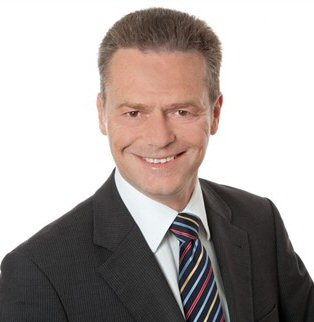
Johannes P. Schwemmer
On Jan. 21, 2019, two European Union government officials responsible for fusion research gave a presentation to the European Parliament Committee on Budgetary Control. One was Johannes P. Schwemmer, the director of the ITER domestic agency for the European Union. The other was Massimo Garribba, the European Commission director who represents Europe on the ITER Council.
Schwemmer told those members of the European Parliament that fusion is a promising source of energy because the “fuels are plentiful and available all over the world.”
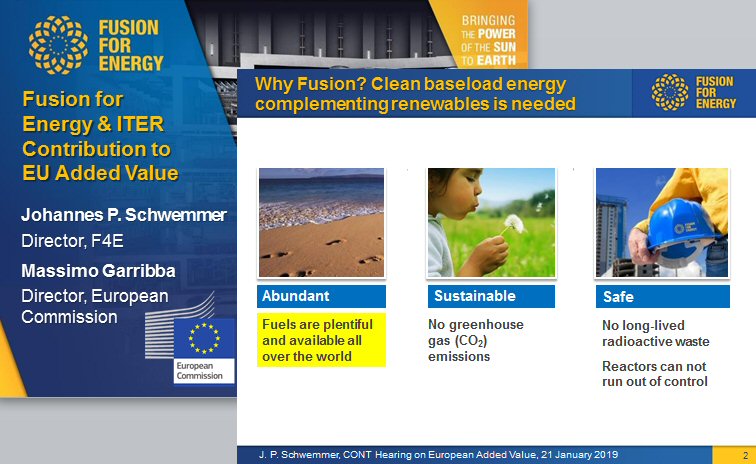
Garribba, through a European Commission spokesman, told New Energy Times that he was not responsible for slide #2 with the false fuel claim.
But Garribba also spoke at the 52nd Japan Atomic Industrial Forum Annual Conference in 2019 and wrote in his abstract that “fusion may also become a new, non-carbon emitting, safe and virtually unlimited energy source in the second half of this century.”
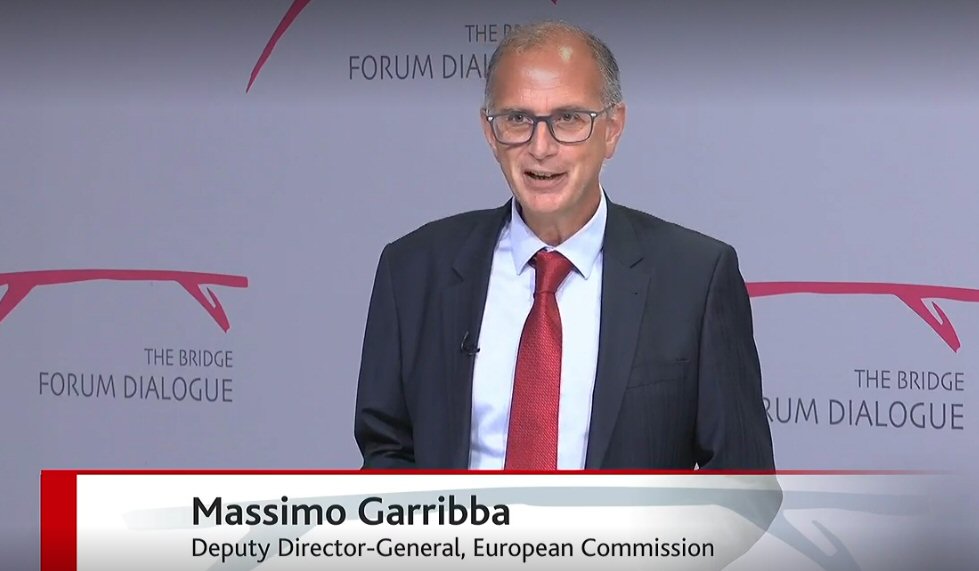
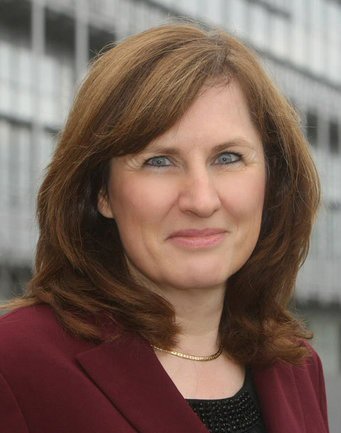
Sibylle Günter
Sibylle Günter
Sibylle Günter is the scientific director of the Max Planck Institute for Plasma Physics. In 2011, Günter gave a briefing to the European Parliament. She told the members of the European Parliament that the fuel components for fusion — deuterium and tritium — were “practically unlimited.”
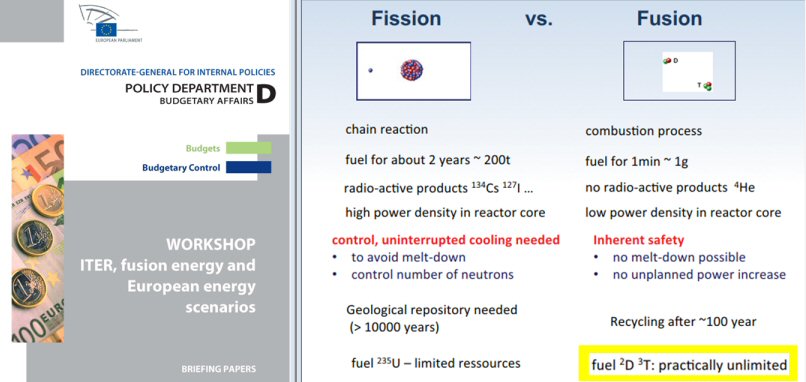
European Parliament workshop cover page (left) and slide from Sibylle Günter (right)
Maria Zuber
Maria Zuber is the vice president for research at the Massachusetts Institute of Technology. She’s also responsible for research integrity at MIT.
In a Sept. 8, 2021, press release, Zuber told MIT science writer David Chandler that the fuel used to create fusion energy comes from water and that “the Earth is full of water — it’s a nearly unlimited resource.”
Zuber’s direct quote is true. Zuber’s indirect quote is false. The MIT press release has other false statements and inaccuracies. Since the MIT fusion department lost its federal funding several years ago, its professors have been making exaggerated claims and promises.
Last year, a New York Times article by Henry Fountain said that MIT professors published “evidence that SPARC would succeed and produce as much as 10 times the energy it consumes.”
This year, a New York Times article by John Markoff that said that MIT’s commercial partner, Commonwealth Fusion Systems, hopes that their SPARC “prototype, when complete, will produce 10 times the energy it consumes.”
In fact, the SPARC reactor concept is not designed to produce any more energy than it consumes.
However, after SPARC, the MIT/Commonwealth scientists have long-term plans to develop another reactor that is designed for a net positive reactor power gain. It has a similar name: ARC.
But was there a miscommunication because of the similarity in names? Absolutely not. That’s because ARC is designed for a reactor gain of only 3, not 10. (See calculations here.) SPARC is designed for a maximum reaction gain of 10.
The MIT/Commonwealth scientists manipulated public perception in exactly the same way the ITER scientists did: misrepresenting reaction power gain as reactor power gain.
That’s exactly how the ITER communications staff misled Fountain when he went to visit the site for this New York Times article. Fountain wrote that, “although all fusion reactors to date have produced less energy than they use, physicists are expecting that ITER will benefit from its larger size and will produce about 10 times more power than it consumes.”
I’ve spoken with Fountain and Markoff. Neither of them, of course, had realized that the scientists or their representatives had tricked them. Both of them seemed perplexed and incredulous. Neither admitted that they were tricked.
Zuber also told Chandler that she believes the SPARC reactor “can achieve net positive energy.” This means that the MIT/Commonwealth scientists fooled their own research integrity officer. I asked Zuber on what data she based her statement about net positive energy. She did not respond to my e-mail.
Other scientists involved in the MIT fusion project told Chandler that “the successful operation of SPARC will demonstrate that a full-scale commercial fusion power plant is practical.”
But the SPARC zero-net-energy design would fail to demonstrate that a full-scale commercial fusion power plant is practical.
The ITER people said the same thing in a 2017 press release: “ITER is a project to prove that fusion power can be produced on a commercial scale.” (Actually, if ITER works properly, it will lose power.)
In a presentation at “Technology Day 2019: MIT on Climate Change,” Zuber told her audience that the president of MIT keeps a close eye on the university’s climate and energy research.
“It’s my honor and privilege to oversee MIT’s climate and energy work,” Zuber said. “President Reif assigned me to do that because this is an important topic to him and it was very important that somebody who reports directly to him was overseeing it so that he could be kept in the loop on a regular basis.”
So there can be no questions about what the president knew and when he knew it, I keep Reif in the loop, as well.
Dennis Whyte
Dennis Whyte is the director of the MIT Plasma Science and Fusion Center. In the same Sept. 8, 2021, press release that featured Zuber, Whyte said, “Fusion is an inexhaustible, carbon-free source of energy that you can deploy anywhere and at any time. It’s really a fundamentally new energy source.”
Whyte went into more detail in a TEDx lecture from 2013:
This is probably the greatest lure of fusion energy. The fuel is so abundant because it is essentially hydrogen. It actually occurs naturally in seawater, and it’s effectively unlimited to all people on Earth.
The example that we’ve put forward here is that, if I extracted a very small portion of and, in fact, harvested these heavy forms of hydrogen from the top inch of Boston Harbor, this would supply all of Boston’s electricity demands for about 100 years. That’s how incredibly intense the energy source is, and you get it from natural seawater. Also, it doesn’t happen to be just where you happen to be on the planet; everybody would have access to the fuel.
So we have a pretty good idea where Zuber got her information from.
Laban Coblentz
Laban Coblentz is the current spokesman for the ITER organization. Here’s what he told environmental journalist Celia Izoard earlier this year:
[Consider] the vast potential for fusion power to reduce and even eliminate more than a century of geopolitical tensions and conflicts focused on competition for access to fossil fuels, by enabling the use of a power-generating technology for which – uniquely among any baseload power generation source – the fuel (in water and lithium) is globally abundant and equally available to all.

Laban Coblentz
Melanie Windridge
Melanie Windridge is a British plasma physicist, spokeswoman for Tokamak Energy Ltd., and the U.K. spokeswoman for the Fusion Industry Association advocacy organization. Here’s what she said at a 2020 science festival:
If we could do this, we could produce abundant energy with no greenhouse gases. We wouldn’t have to worry about running out of fuel because the types of hydrogen we need come from readily available sources like seawater.
International Atomic Energy Association
The world’s most influential leaders in the nuclear fusion community belong to the International Fusion Research Council, a standing advisory body of the International Atomic Energy Association. The council has made counterfactual fusion fuel claims, too. Here’s an example from 2005:
Fusion is, today, one of the most promising of all alternative energy sources because of the vast reserves of fuel, potentially lasting several thousands of years.
This IAEA fuel claim brings us full circle, back to the paper that Abdou and his colleagues published online last year, and in print this year, in the IAEA’s scientific journal Nuclear Fusion.
Nuclear Fusion is widely recognized as the leading journal in the field of nuclear fusion research. The list of co-authors below represents six of the most prestigious fusion organizations in the world, including the ITER organization. There’s a good chance that everybody in the fusion community knows about this scientific paper.
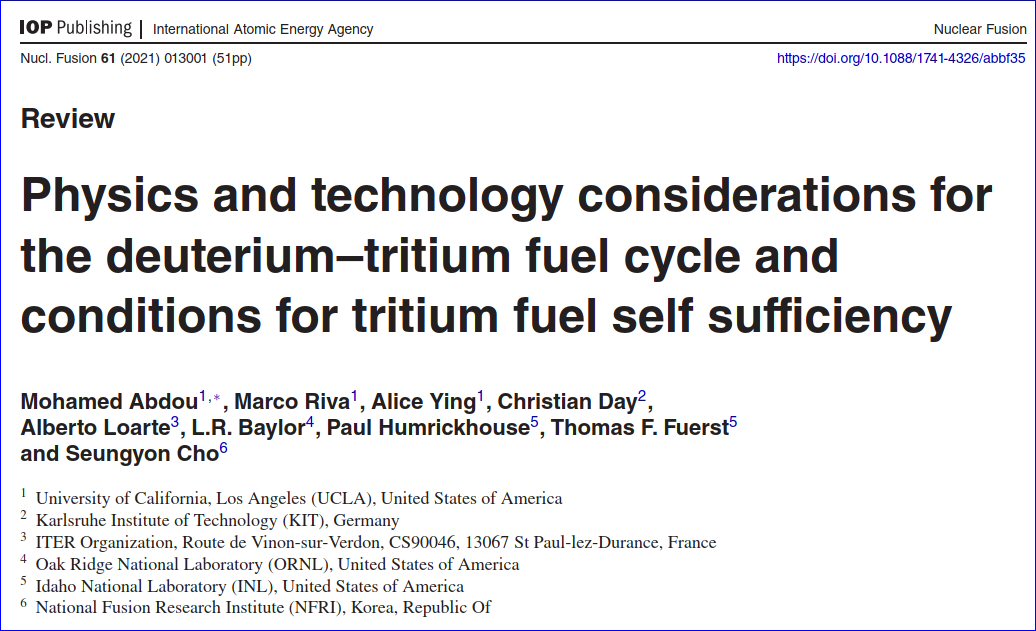
Bernard Bigot
Bernard Bigot, the director-general of the ITER organization, gave a video presentation on June 10, 2021, organized by the Bridge Forum. A press release, distributed by the organization a day after the videoconference, said that, according to Bigot, “fusion energy is a predictable baseload power source.”
For 70 years, fusion promoters have been making the same predictions. In 70 years, fusion energy has not delivered a single Watt of usable power.
Here is what the organizers said about Bigot’s fuel claims in their June 11, 2021, press release:
The speaker indicated that fusion fuel, which is made of two isotopes of hydrogen – deuterium and tritium – is virtually unlimited for hundreds of millions of years and evenly distributed across the globe.
Bigot also told a half-truth about the planned power goal:
What is the ITER mission? … The goal is to achieve a yield of over 10, which means that the thermal output will be on the order of 500 megawatts while we are just feeding into the plasma 50 megawatts of heating power.
Bigot neglected to mention that 300 megawatts of electricity will also be needed to operate the experiment and produce the 500 megawatts of thermal power.
Bigot also told the audience that the first fusion power plant might be “connected to the grid in Europe by 2060.”
Each of the 200 fusion reactors that have been built in the past 70 years has been “connected to the grid.” So the phrase “connected to the grid” doesn’t mean anything about power contribution to the grid, let alone doing so cost-effectively.
Michio Kaku
Last, we have television’s favorite physicist: Michio Kaku, an American professor of theoretical physics. Kaku spoke with CNBC in August 2021 and told viewers about a “breakthrough” at the Lawrence Livermore National Laboratory National Ignition Facility.
Kaku told viewers that the laser fusion device “hit breakeven: to extract more energy than you put in.”
Actually, laser fusion scientists have four definitions for breakeven. Kaku didn’t realize this and thus inadvertently led viewers to think that the device extracted more energy than was put into it. It didn’t come close.
Here’s what Kaku said about fusion fuel:
And the fuel — the fuel is seawater! Hydrogen from seawater could be the basic fuel. So this is too good to be true.
Too Good to Be True
Unfortunately, the last part of Kaku’s statement is where he got the story right. But it’s not his fault. He didn’t know. He trusted and believed the fusion scientists who have dominated the public messages.
We all did.
Next: ITER and The Fusion Discrepancies

